Introduction
The narrative of the Greek gods, goddesses, and related mythology, unlike the Bible, was not available to the ancient Greeks through a singular compilation of texts. Instead many of the characters and their backstories were borne by the oral traditions developed during the Mycenaean Bronze Age. Now, of course, the greatest example of Classical Greeks being inspired by their ‘ancestors’ comes from the epic poetry of Homer in the Iliad and Odyssey.
To that end, rather than a historical exposition of how Mycenaeans fought and behaved, these epic literary works (and Homeric hymns) should be viewed more like a compilation of folkloric traditions that were passed down through generations from around 9th-8th century BC (three centuries after the passing of the Mycenaeans).
In any case, the mythical Greek gods, heroes, and monsters (a few of whom make their way into the Iliad and Odyssey) epitomized various scopes, ranging from religious rites to weather. Simply put, the array of entities provided the ancient folks of Greecefolks with the meaning of worldly and natural cycles, which rather justified their existence within the framework of mythology.
And historically, it was probably the poet Hesiod’s Theogony that compiled the first known origin story of Greek mythology, circa 700 BC. He was followed by various other Greek playwrights and poets (like Aeschylus, Sophocles, and Euripides) who played their part in expanding and even refashioning some elements of the vast Greek mythology.
Considering these historical factors, let us take a gander at 20 major Greek gods and goddesses, including both Titans and Twelve Olympian Gods, you should know about.
Contents
- Introduction
- The Primordial Greek Gods –
- The Titans –
- The Olympian Gods –
- Zeus – The King of Greek Gods
- Poseidon – The God of Seas
- Hades – The God of the Underworld
- Hera – The Goddess of Domestic Affairs
- Demeter – The Goddess of Harvest
- Aphrodite – The Goddess of Beauty and Love
- Athena – The Protector Goddess
- Ares – The God of War
- Hephaistos – The God of Metallurgy
- Apollo – The God of Prophecy
- Artemis – The Goddess of Hunt
- Hermes – The Messenger God
- Hestia – The Goddess of Hearth
- Honorable Mention: Dionysus – The God of Wine
- Summary –
- The Family Tree of Greek Gods and Goddesses –
The Primordial Greek Gods –
Gaia – The Earth Goddess

Previously, we talked about the primeval entities of both Mesopotamian and Egyptian mythologies, in the form of Tiamat and Nun respectively. Well, in the case of Greek mythology, the role of a primordial deity (protogenoi) at the beginning of creation is played by Gaia (or Gaea).
In essence, she was regarded as the mother of all creation, whose conception signaled the starting of order after a long period of chaos (the symbolic scope of void or abyss). And thus all the gods and goddesses of Greece descended from her lineage, with the first generation being born from her union with Ouranos (or Uranus), the sky god.
And like other ancient mythologies, this primordial Greek goddess was initially depicted on a positive note. But ultimately she took the form of an antagonist. The positive narrative is alluded to by her heroic actions against her husband (and later her son), when Ouranos imprisoned many of their offspring – comprising giants, inside her womb.
However, as the Olympian Greek gods (discussed later) gained ascendancy in the pantheon of Greek deities, Gaia’s portrayal took a somewhat negative turn. This is hinted at by her conspiracy against Zeus, the king of Olympian gods. She planned to overthrow him in retaliation for the imprisonment of the Titans (Gaia’s other sons with Ouranos) in Tartaros, the abyss within the underworld.
Interestingly enough, in spite of such abstract aspects and narratives, Gaia was often visually depicted in a simple manner, as a buxom, matronly woman rising from the ground, sometimes garbed in green – thus signifying her association with Earth.
Ouranos – The Sky God
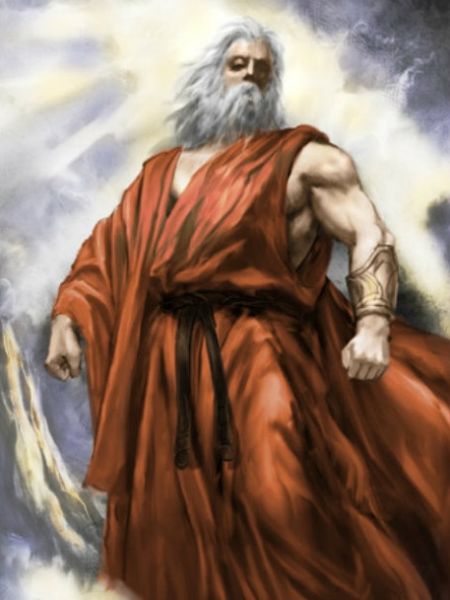
Ouranos (or Uranus), the male counterpart to ‘earthly’ Gaia, was the protogenoi of the sky. To that end, ancient Greek mythology perceived the sky as a solid dome of brass, embellished with shiny stars, whose edges literally rested upon the flat ends of the Earth – thus symbolically uniting both Gaia and Ouranos, the primeval Greek gods.
This union created the first batch of giants – the one-eyed Cyclopes and the hundred-limbed Hecatoncheires. In the mythical narrative, unfortunately for the giants, their father became wary of their power and thus ordered Gaia to imprison them in her womb. However, Gaia, unable to bear the pain, struck an alliance with her next ‘set’ of offspring – the Titans, and together they managed to overpower Ouranos.
The crucial blow was struck by Kronos (or Cronus – the youngest among the Titans). His well-timed slash with an adamantine sickle managed to castrate Ouranos. But as the sky god lost his power, and Kronos gained supremacy among the Greek gods, Ouranos prophesied how his Titan son would be deposed in a similar manner by the next generation. This later proved to be true with the mythical lore of Zeus and his brothers.
In any case, the grievous injury to Ouranos had its side effects, with his blood producing the vengeful Furies (Erinyes) and the unruly Giants (Gigantes), and his castrated member giving birth to Aphrodite, the Greek goddess of beauty and sex.
As for the historical side of affairs, there are no known depictions of Ouranos in early Greek art, though he may have been imagined as a literal gargantuan man who arched his back to replicate the (perceived) domed nature of the sky.
The Titans –
Kronos – The Titan of Time
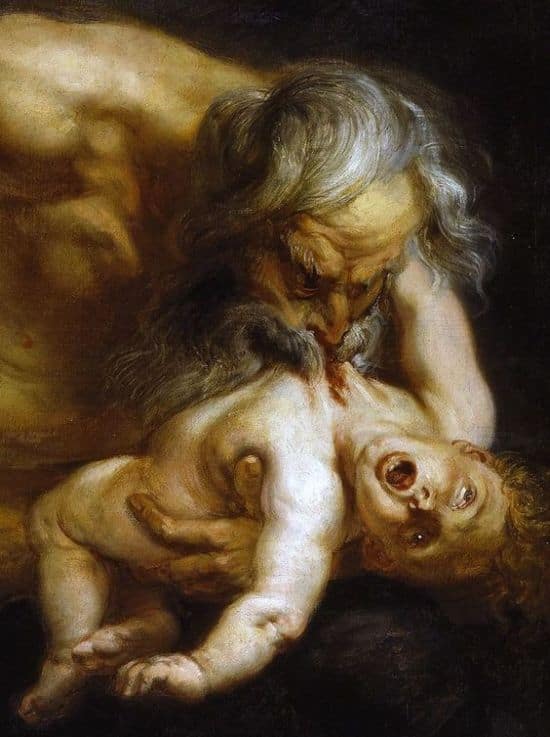
Kronos (or Cronus), the youngest son of Ouranos and Gaia, was also the father of the ‘first generation’ of Olympian Gods (like Zeus, Hades, Hera, etc). In mythology, he embodied the ‘all-devouring’ aspect of time, along with fate, justice, and even evil.
During his reign, corresponding to the proverbial Golden Age, Kronos was regarded as the head of the Titans, after playing the crucial role in overpowering and castrating his tyrant father Ouranos.
Unfortunately for Kronos, the prophecy of Ouranos alluded to how Kronos himself would be deposed by his own sons. Learning of this ominous foretelling, Kronos went on to swallow all of his sons and daughters, with the exception of Zeus, who was saved by his mother Rheia (Kronos’ wife), and remained hidden on the island of Crete.
After growing up, Zeus took the fight to his father and managed to secure the freedom of his brothers and sisters from Kronos. And then Zeus banded together with these now-called Olympian Gods and battled with Kronos and his allied Titans. This event finally led to the banishment of the Titans to Tartaros.
Quite intriguingly, in some compositions of Greek mythology, Zeus later had a change of heart (after generations of men) which allowed Kronos to come back and rule over Elysian Islands, home of the blessed dead.
In any case, when it comes to portrayals, Kronos was often depicted as a well-proportioned man with a black or grey beard, wearing a simple robe. This is what 1st century BC Stoic philosopher Quintus Lucilius Balbus (as noted by Cicero in his book De Natura Deorum or ‘On the Nature of the Gods’) had to say about Kronos and his equivalent Saturn –
By Saturn, they seek to represent that power that maintains the cyclic course of times and seasons. This is the sense that the Greek name of that god bears, for he is called Kronos, which is the same as Chronos or Time. Saturn for his part got his name because he was “sated” with years; the story that he regularly devoured his own children is explained by the fact that time devours the courses of the seasons and gorges itself “insatiably” on the years that are past. Saturn was enchained by Jupiter (Zeus) to ensure that his circuits did not get out of control and to constrain him with the bonds of the stars.
Hyperion – The Titan of Light
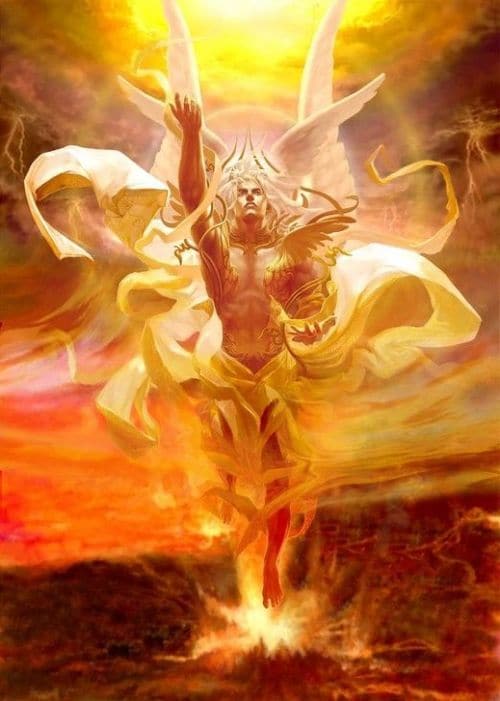
Hyperion was one of the Titan (Titán) sons of Ouranos and Gaia and thus belonged to the first generation of Greek gods. He signified the very essence and scope of heavenly light. Concurrently, his sister/wife Theia (meaning ‘divine’) was the manifestation of the brightness of the blue sky.
To that end, even their offspring were counted among the deities of light and heavenly bodies, including Helios, the god of the Sun, Selene, the goddess of the Moon, and Eos, the personification of the Dawn.
The etymology of the very name Hyperion also alludes to his association with the light and the sky, as it literally means “he who looks from above”, thus being related to the term hyper meaning “over, above, or beyond”.
As one of the Titans (Titanes), Hyperion took part in the coup to overthrow their father Ouranos from the figurative position as the head of the pantheon of the ‘older’ Greek gods.
During the feat, Hyperion along with his three other brothers Krios (Crius), Koios (Coeus), and Iapetos (Iapetus) held Ouranos in a position while Kronos fatefully wielded his sickle. And in spite of being a relatively obscure figure in Greek mythology, given his relation to the dawn and light of the sun, Hyperion was considered the Titan of the pillar of the East.
Oceanus – The Titan of Water
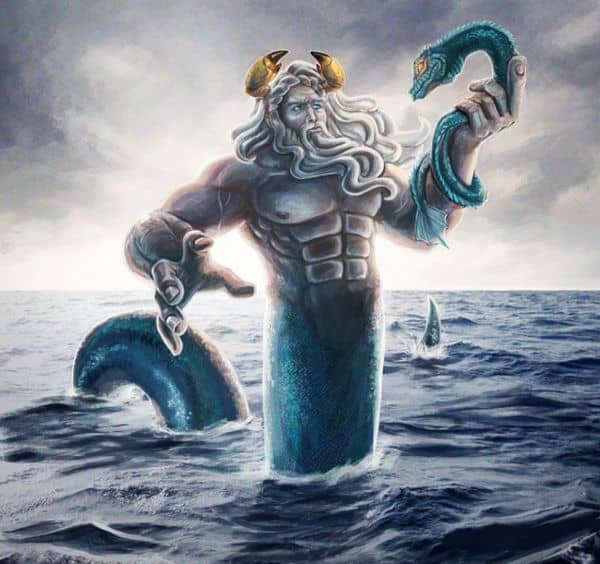
Okeanos (or Oceanus) was the personification of the massive River Okeanos that was thought to have encircled Earth itself – since the landmasses of Eurasia and Africa (collectively the ‘Earth’) were only known to the Greek sailors. He was also one of the sons of Ouranos and Gaia, thus being a preeminent Titan.
In essence, much like Hyperion and his association with the vast scope of light, Okeanos was perceived as the monumental ‘receptacle’ that held the entirety of the planet’s water. To that end, Okeanos signified all of earth’s fresh-water – rivers, wells, springs, and even rain clouds. And his three-thousand children, with his wife Tethys (‘the Nurse’), were also the mythical entities and nymphs (Oceanids) representing the various water bodies and rivers.
However, unlike Hyperion (and Kronos), Okeanos was not involved in the power struggle with his father Ouranos. Befitting his non-partisan character in Greek mythology, Okeanos also didn’t take part in the conflict between the Titans and the later Olympian Greek gods.
Interestingly enough, when maritime activities increased during the Hellenistic era, Okeanos possibly represented some aspects of the vast water bodies of what we know as the Indian and Atlantic Oceans – thus providing the etymological root of the word ‘ocean’. As for his depiction, the river god was often portrayed as a hybrid bull-horned god with the tail of a serpentine fish and sometimes just as a serpent (especially in his sea-god aspect).
Atlas – The Titan of ‘Burden’
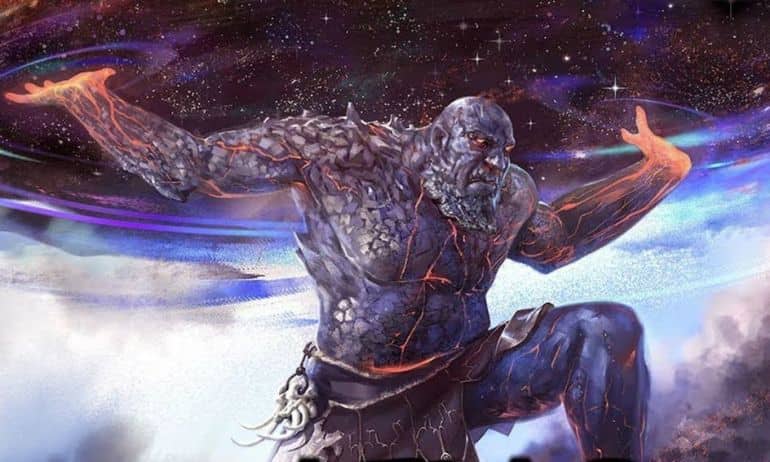
Atlas was the son of the Titans Iapetos and Clymene (or Asia), and the brother of Prometheus. He led the Titans in their war against the ‘next generation’ Olympian gods (the descendants of Kronos) for control of the heavens. As while most of the Titans were banished to Tartaros by the victorious Olympians, Atlas was destined for a special punishment chosen by Zeus, the leader of the Olympian gods.
He was given the unenviable task of bearing the weight of the heavens on his shoulders while standing at the Western edge of Gaia (the personification of Earth). In the mythical narrative, this was supposedly done so that the sky and the earth (possibly representing Ouranos and Gaia) are separated from taking part in their primordial embrace – an intimate act that originally gave birth to the Titans.
Homer’s Odyssey talks about the distant pillars in the Atlantic Ocean that held the sky. Hesiod’s Theogony places this western land as the realm of the Hesperides, the singing deities.
And interestingly enough, 5th century BC traditions associated the Atlas mountains of North Africa with the physical remnants of Atlas himself, after he was turned to stone by Perseus using the head of Medusa. In any case, the most famous episode of Atlas in Greek mythology arguably relates to the golden apple episode of the Twelve Labors of Heracles (or Hercules).
Prometheus – The Creator of Mankind
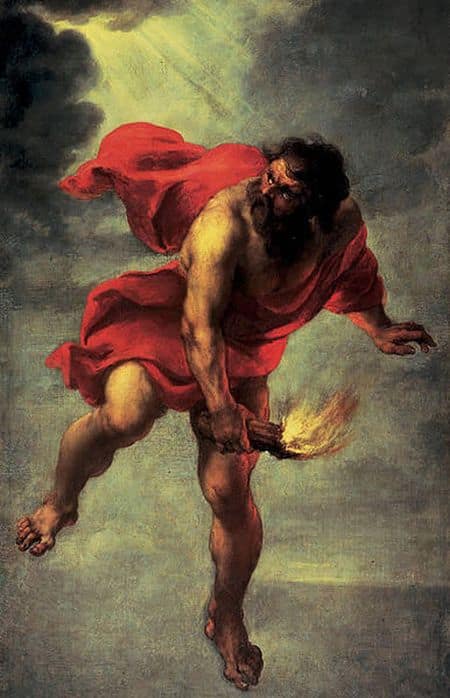
Prometheus, the brother of Atlas, embodied the aspects of forethought and crafty machinations. And like Atlas, he was one of the early ringleaders of the Titans in their battle against the next-generation Olympian gods
Although afterward, he changed sides because the Titans didn’t take too kindly to his ‘tricky’ counsel. Anyhow, Prometheus’ ‘claim to fame’ in some narratives of Greek mythology comes from his status as the creator of mankind.
To that end, according to one version, he was the one to create the very first man from clay. Another version suggests that the Greek gods already created their living creatures on Earth, and Prometheus (along with his brother Epimetheus or Afterthought) was tasked with endowing these species with gifts for survival and eventual prosperity.
However, on reaching men, all the impressive gifts, like flight and fur, were already expended. So Prometheus took pity on the vulnerability of mankind and snatched away the choicest meat portions from Zeus’ meal to nourish the first men. He also stole fire from the heavens and delivered it to the mortals hidden in a fennel stalk.
Unfortunately, for the Titan, Zeus was angered by these seemingly rebellious acts, and thus Prometheus was arrested and bound to a stake on Mount Kaukasos (Caucasus) where an eagle was set to voraciously feed upon his ever-regenerating liver (or heart) – thus resulting in a perpetual state of torture.
Furthermore, in the mythical narrative, Zeus, along with Hephaistos, also created the first woman Pandora, who was to become the cause of woe and suffering for mortal mankind. But the old Prometheus was fortuitously saved from his daily ordeal by Heracles after the latter successfully shot the eagle. As for the historical side of affairs, interestingly enough, Prometheus was worshipped by potters (especially in ancient Athens), given his association with fire and kilns.
The Olympian Gods –
Zeus – The King of Greek Gods
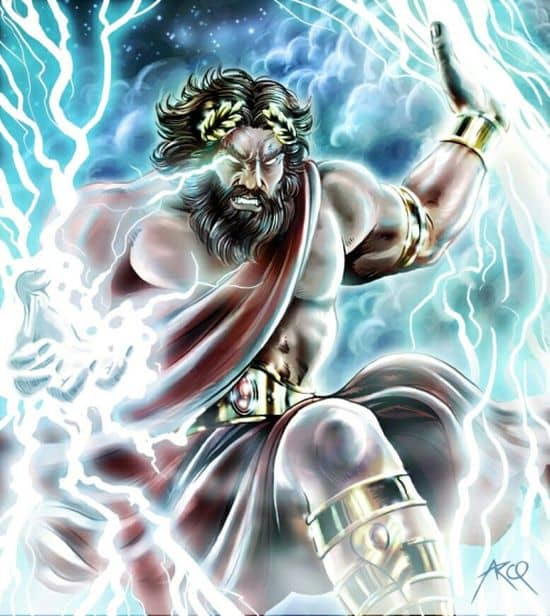
We have talked about Zeus and how he was one of the founders of the Olympian family of Greek gods – named so because of their mythical abode atop Mount Olympus (or Olympos). In the narrative of mythology, the ascendancy of these twelve Olympians was marked by the defeat of the Titans, the previous class of the ruling Greek gods.
This ‘rise to power’ provided its fair share of accolades for Zeus, as he was regarded as the King of the Gods, who embodied the various aspects of the sky, weather, law and order, destiny and fate, and kingship. In that regard, it was believed that his temper affected the very pattern of weather and thunderstorms.
In essence, Father Zeus was the supreme deity of the ancient pantheon, with his very name being derived from the Proto-Indo-European root *dyeu– (‘to shine’), thus bearing similarity to Dyaus/Dyaus Pita, the sky god mentioned in Sanskrit Rigveda. Reverting to the ancient Greek scope, some of the later-mentioned aspects were directly usurped from Kronos.
In any case, in the continuation of the mythical narrative, after the defeat of the Titans and their banishment, Zeus drew lots with his brothers over the division of the cosmos and ended up with guardianship of the heavens and Mount Olympus. And while he was lawfully wedded to the Greek goddess Hera, the queen of the heavens, their union was not exactly a peaceful one, in spite of producing a number of minor gods and goddesses.
The domestic ‘incompatibility’ perhaps had to do with Zeus’ numerous amorous adventures with other goddesses, nymphs, and even mortal women. Zeus even used Echo, a beautiful yet old mountain nymph, who distracted Hera with fascinating tales, while Zeus sneakily used the opportunity to ‘make the acquaintance’ of other alluring nymphs.
As expected, the arrangement didn’t work for long. Hera in her wrath cursed Echo which took away her enticing voice-only leaving her to dully repeat words that other people have shouted.
Suffice it to say, in Greek mythology, Zeus, through his affairs, sired a number of Greek gods, demigods, Greek heroes, and even monsters; ranging from Persephone, Apollo, and Dionysus to Perseus, Heracles, and the Nemean Lion.
As for his portrayal, Zeus, whose name first cropped up in Mycenaean Linear B, was historically depicted as a robust man dressed in regal attire, sporting his dark beard, royal scepter, and an eagle. And since we brought up history, the Temple of Olympian Zeus in Athens was originally envisaged by its builders, the Athenian tyrants of the 6th century BC, to be the greatest of all Greek temples.
It was planned to surpass even the Temple of Artemis at Ephesus – considered one of the ancient Seven Wonders of the World. Consequently, the initial work on the massive complex suggested such an ambitious scope, with the core platform alone boasting an area of 354 ft by 135 ft, almost equivalent to the size of an American football field.
However, the construction was stopped when the Athenian tyranny was overthrown, with Hippias being expelled in 510 BC (which in turn started a chain of events leading up to the Battle of Marathon).
Poseidon – The God of Seas
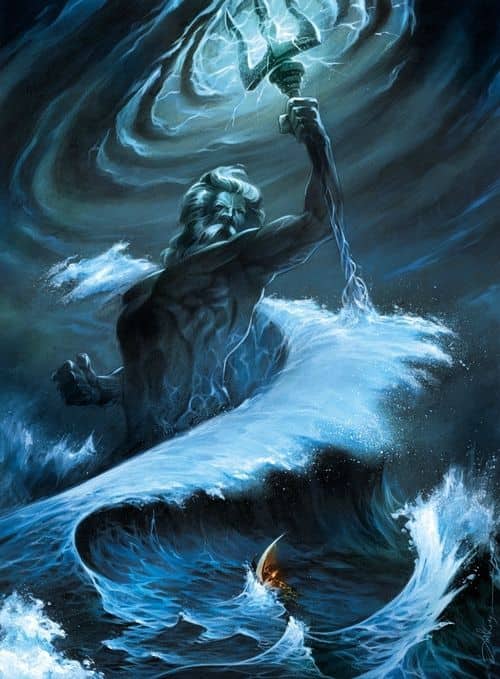
Poseidon, the second son of Kronos and brother of Zeus, together with his brethren and other Olympian Greek gods, successfully defeated the Titans – partially aided by the renowned trident crafted by the Cyclopes. And after drawing lots with his brothers Zeus and Hades, he ended up with the rule over the realm of seas.
Thus among the twelve great gods, Poseidon was regarded as the lord of the seas, floods, and droughts. Eventually, he was also associated with earthquakes and horses. And interestingly enough, his intricate relationship with seas and waters was rather reinforced in the legends – by making him the spouse of Amphitrite, one of the granddaughters of the Titan Okeanos (or Oceanus), the original Greek god of the oceans.
And since we are talking about ancient myths, Poseidon and his rather quarrelsome personality are featured in many of them. One of the notable ones pertains to how he competed with Athena for dominion over Athens and produced the very first horse as a gift. However, his prize was denied, and in, anger Poseidon afflicted the city-state with drought.
Another story talks about how he ended up scattering up the hero Odysseus’ fleet after the latter blinded Poseidon’s cyclopean son Polyphemus. Plato even mentioned how the legendary Atlantis was the domain of Poseidon – where the sea god resided in his underwater beautiful palace.
Interestingly enough, taking the historical route, Poseidon possibly started out as Poseidon-Wanax, a Chthonic figure who was regarded as the god of the underworld and may have been associated with the earthquakes in regions of Crete and Mycenae.
Hades – The God of the Underworld
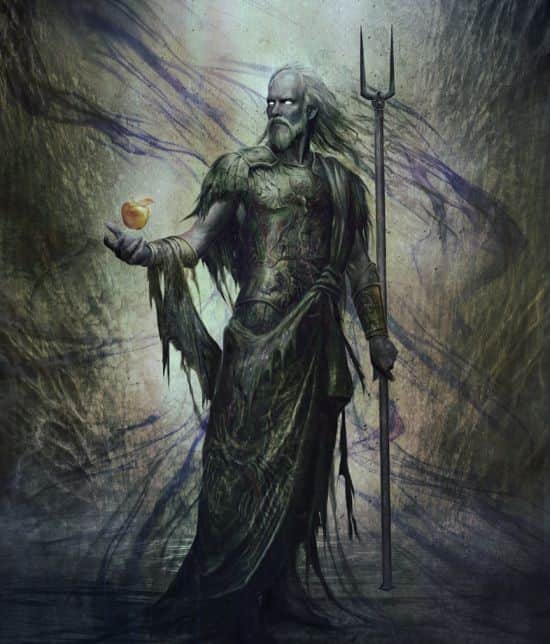
Hades (or Aïdes – meaning ‘the Unseen’) was the oldest son of Kronos and thus the eldest among the Twelve Olympians. He was perceived as a mysterious figure who was held in awe and fear by the common folks– so much so that even speaking his name was superstitiously avoided.
Instead, the ancient folks used euphemistic epithets like Eubuleus (giving good advice) and possibly even Ploútōn, a term with a root meaning ‘wealthy’, used by the 5th century BC, and ultimately the origin of Pluto – the Roman equivalent of Hades.
As for the mythical side of affairs, after the defeat of the Titans, Hades gained rulership over the underworld, a dark and brooding place that also bore the name of its king – Hades. This ‘hidden’ world was possibly also the source of wealth, like precious metals that the deity greatly coveted.
Unsurprisingly, Hades didn’t feature much as a protagonist in myths involving the Twelve Olympians. However, he does play a part in the relationship between the Greek goddess Demeter and her own daughter Persephone – discussed later in the article.
Furthermore, in spite of his seemingly sinister characterization in mythology, the underworld of Hades shouldn’t be viewed as being completely analogous to hell. Instead, it was originally regarded as the final resting place for the souls of ordinary mortals (while the souls of the heroes and the righteous went to the ‘paradisiacal’ Elysian Fields).
But over time, the dark realm was perceived as an abstruse series of ill-boding zones, guarded by the monstrous three-headed (or fifty-headed, as mentioned by Hesiod) dog Kerberos (or Cerberus), whose ‘distant’ lower depths were reserved for the sinners for an eternity of labor and torment.
Hera – The Goddess of Domestic Affairs
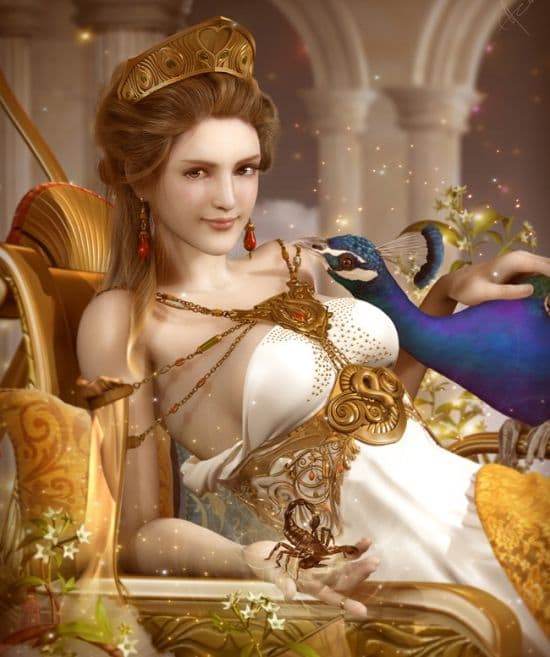
Hera, the queen of the Twelve ruling gods, embodied the aspects of marriage, women, childbirth, and even the stars in heaven. And considering her lineage as possibly the eldest daughter of the Titan Kronos (in some myths, goddess Hestia is the eldest daughter), she was also the sister to Zeus, the king of the Olympians.
Pertaining to the latter, there is a famous myth of how the shapeshifting Zeus transformed himself into a cuckoo to secure the affection of Hera and ultimately seduce her. Unfortunately, as we mentioned earlier, their union was not exactly a happy one, partly due to the nature of Zeus’ string of affairs with other women – gods and mortals alike.
In fact, one particular episode from Greek mythology also relates to how Hera stirred up a full-fledged rebellion among the Greek gods against Zeus, which resulted in the King of the Olympians being tied up on his own couch. Fortuitously for Zeus, he was saved by one of his hundred-limbed Hecatoncheires guards.
In any case, as for the historical side of affairs, the cult of Hera was closely associated with the island of Samos. To that end, the Heraion of Samos, dating from the Late Archaic period circa 8th century BC), was one of the first free-standing Ionic temples.
It was a massive sanctuary solely dedicated to the Greek goddess. And befitting her title as the queen of the ancient Greek gods, she was depicted as a beautiful woman wearing a crown and holding a royal, lotus-tipped scepter.
Demeter – The Goddess of Harvest
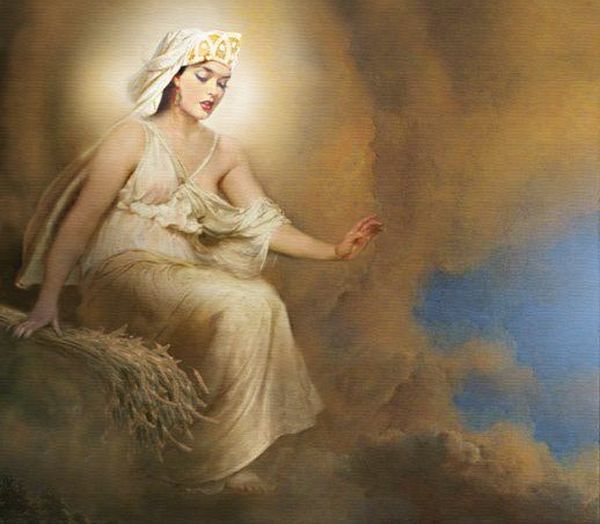
Demeter was the daughter of Kronos and Rhea and hence belonged to the first generation of Olympians. She was the goddess of agriculture, harvest, grain, and bread. In essence, she embodied the sustaining force of earth and thus was often depicted as a matronly woman bearing sheaves of wheat or a cornucopia (the ‘horn of plenty’ symbolizing abundance and nourishment).
Consequently, she was given the epithets of the Lady of the Fruits (of the earth) and the Bringer of seasons – with the latter aspect being symbolically mentioned in Greek mythology through a particular episode involving Demeter and her beloved daughter Persephone.
Essentially, this translated to a tragic story in which Demeter, the deity of growth and harvest, lost her daughter when she was kidnapped by Hades (as he fell in love with her).
And even after the intervention of other Greek gods, Persephone was only allowed to return to earth and spend time with her mother from spring to autumn, thus essentially symbolizing how her parting caused the leaves to fall and stunted nature’s growth – until the cyclic arrival of next spring.
Historically, the role of Demeter and her ‘periodic’ daughter Persephone may have been re-enacted in the Eleusinian Mysteries, the enigmatic annual initiation ceremonies held in ancient Greece that possibly predated the pantheon of the Olympian Greek gods.
The cult in itself was based at Eleusis and its rituals and beliefs (that had their ancient versions being performed in other realms, including Crete, Near East, and later Rome) were mostly kept secret on a consistent basis for around two millennia.
Aphrodite – The Goddess of Beauty and Love
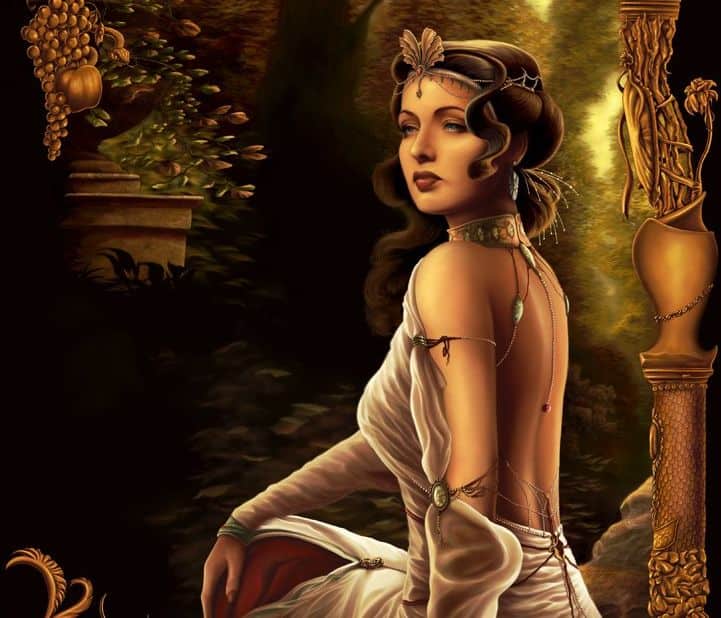
Aphrodite was an ancient female deity representing beauty, sexual love, and pleasure. She was unique among the ancient Greek gods and goddesses because she was counted among both the first generation of divine beings and the subsequent twelve gods of Mount Olympus.
The first categorization relates to her birth, which according to Hesiod, resulted from the ‘foamy’ seed of the Ouranos (represented by the sea foam) – as mentioned before in the article (see Ouranos entry). The second categorization comes from Homer’s Iliad, where she is mentioned to be born from the union of Zeus and Dione (an oracular female Titan).
Interestingly enough, Plato went on to differentiate between these two entities by describing how the goddess had variant aspects, with the first one being accorded the epithet of Aphrodite Ourania (the ‘Heavenly Aphrodite’) and the second being called Aphrodite Pandemos (Aphrodite ‘common to all the people’).
Other names of the Greek goddess include Cytherea (Lady of Cythera) and Cypris (Lady of Cyprus), with each of the locations being mythically related to her birthplace. Later on, she was also identified with Roman Venus.
Now given her embodiment of love and pleasure in Greek mythology, it doesn’t come as a surprise that Aphrodite took many lovers – both Greek gods and mortals, including Ares, Adonis, and Anchises; and produced a lot of children, including Harmonia, Phobos, Eros, Hermaphroditus, and even Aeneas (the mythical ancestor of the legendary Remus and Romulus – founders of Rome).
But beyond her seemingly simple characterization in the mythical narrative, it is the historical scope of Aphrodite that demands more attention. In that regard, the cult of the deity is believed to have been derived from the Phoenician goddess Astarte.
The latter was probably a cognate of the East Semitic/Assyrian goddess Ishtar, whose cult was based on the originally Mesopotamian (Sumerian) cult of Inanna. Quite intriguingly, like in the case of Ishtar, Aphrodite, in spite of her association with love and desire, was also revered as a warrior goddess, especially in Laconia (Sparta).
Athena – The Protector Goddess
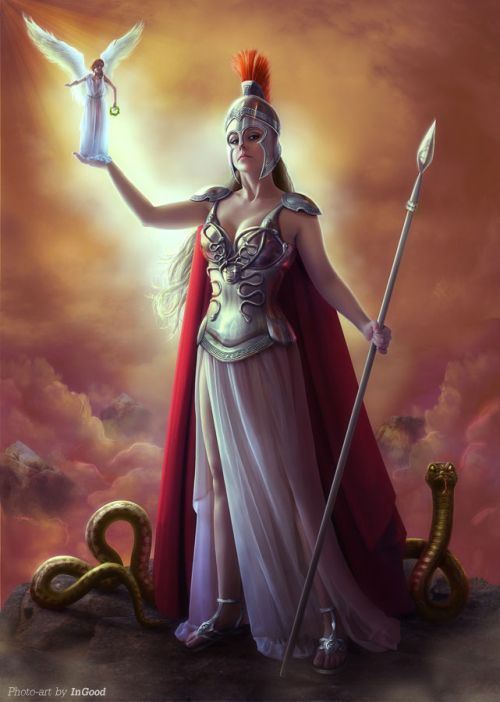
In Greek mythology, there are some narratives about the birth of Athena (or Athene) that rather mirror the motif of ‘insecurity’ of the previous rulers of the Greek gods, like Ouranos and Kronos.
Only this time around, it was Zeus who was responsible for swallowing up a nymph named Metis, after he heard a similar-sounding prophecy from Kronos that mentioned how the child born of their union would one day become the lord of heaven, thus usurping his position.
Hence it is said that Athena was birthed from Zeus’ forehead, and she sprang forth in her fully mature form draped in armor. Her physical maturity matched her steadfast personality, with the deity being counted among the wisest, courageous, and resourceful of the twelve gods.
Unsurprisingly, she was regarded as the ancient Greek goddess of both endurance and strategic warfare, while she also embodied the aspects of wisdom, strength, and reason. Athena was often called by her various honorable epithets, like Parthenos which simply meant ‘virgin’ – a title she lived up to given her distaste for illicit affairs.
Even more fascinatingly, she was also called Promachos, meaning ‘of war’, which alludes to her aspect of defensive warfare and strategy. The title and its symbolism hinted at a more patriotic sense of conducting war, as opposed to unwanted battle frenzy and warmongering. In fact, the olive tree and the owl were considered symbols of the protector goddess.
The goddess also plays a crucial role in the founding myth of Athens, where she bests Poseidon and emerges as the patron deity of Athens, a legacy of the legend being epitomized by the still-standing Parthenon dedicated to Athena Parthenos. As the daughter of Zeus, she was also the favorite child of her father – so much so that she was even allowed to wield his powerful weapons.
And lastly, when it comes to history, the name Athana Potana was mentioned in one of the Linear B tablets at Knossos, which suggests how the entity possibly started out as the Aegean goddess of the palace, who embodied the aspects of the royal protector and the inspiration behind household crafts.
Ares – The God of War
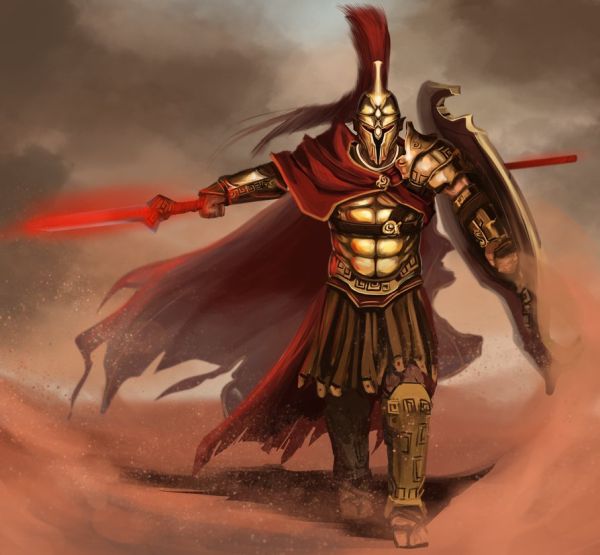
Ares, the son of Zeus and Hera, epitomized war and mayhem in its full flourish among the major twelve gods. In essence, as opposed to the tact and reserve of Athena, Ares embodied the ‘untethered’ battle-lust, which rather made him an antagonistic character in some episodes of Greek mythology.
To that end, one of the myths talked about how Heracles managed to disgrace the ancient Greek god of war by spearing him in the thigh. In yet another episode, the rash Ares was defeated by the Aloadai giants who laid siege to Olympus, and he had to be ultimately rescued by Hermes.
Talking of Greek myths, one of the more risque ones involved his illicit affair with the married Aphrodite (the wife of Hephaistos). Their union, according to Hesiod, was said to have produced Phobos and Deimos, the personifications of fear and terror respectively, who accompanied their grim father in battles.
Now interestingly enough, while many of the legends of the god of war were not exactly appreciative of the deity’s actions, the name of Ares was invoked by the Greek hoplites before actual battles.
For example, the Spartans were known to have made sacrifices to Enyalius, possibly a lesser deity who was either regarded as the son of Ares and Enyo (the Greek goddess of destruction) or the embodiment of Ares himself. In terms of imagery, Ares carried a bloody spear, while his symbols included vultures and dogs.
Hephaistos – The God of Metallurgy
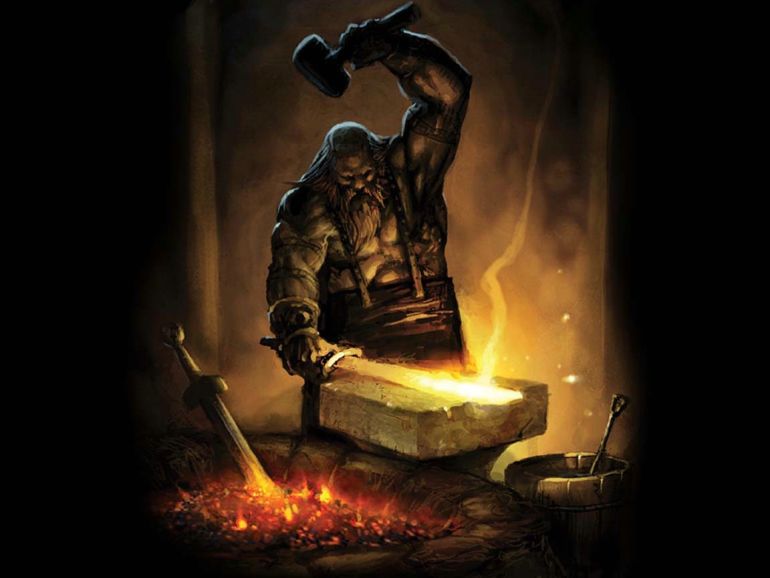
Another one of the second generation of Olympians, Hephaistos (or Hephaestus), and his portrayal was rather antithetical when it came to the assumed physical qualities of a Greek god or goddess.
To that end, he was considered somewhat uncomely by his divine peers – with his mother Hera (in many narratives he was said to have no father, while in some versions his father was Zeus) even casting him away from the heavens, apparently because of his looks and a deformed leg.
Utterly disgraced, the ‘lame’ god landed on the island of Lemnos. But showcasing his inherent doughtiness, Hephaistos managed to become a master craftsman who constructed his ‘secret’ workshop on the island’s volcano. Thus in Greek mythology, Hephaistos embodied the aspects of fire, metallurgy, and crafts, thus becoming the patron god of smiths and weavers.
In the myth, Hephaistos even managed to take his revenge on his inconsiderate mother by trapping her on a magical golden throne. And thus he became the first of the Greek gods to come back from exile to heaven (Mount Olympus) after he was intoxicated (by the other gods) and led to Olympus to free Hera. The scene of the return of Hephaestus was a popular motif in Attic vases, where the god was depicted as being led by Dionysus, the deity of wine and festivities.
Afterward, he became the master blacksmith of the Olympian Gods and is credited with making the scepter and aegis of Zeus, the helmet of Hermes, secret locking doors for the chambers of Hera, and the giant automaton Talos for King Minos. However, his crowning achievement arguably relates to the creation of the first woman Pandora, who was made from clay.
And while he managed to even marry Aphrodite (as a reward for freeing Hera), the most beautiful of all the Olympians, his domestic life wasn’t exactly a happy one – with Aphrodite having affairs outside of her marriage. As for history, the first mention of Hephaistos possibly comes from a Bronze Age Linear B inscription at Knossos.
Apollo – The God of Prophecy
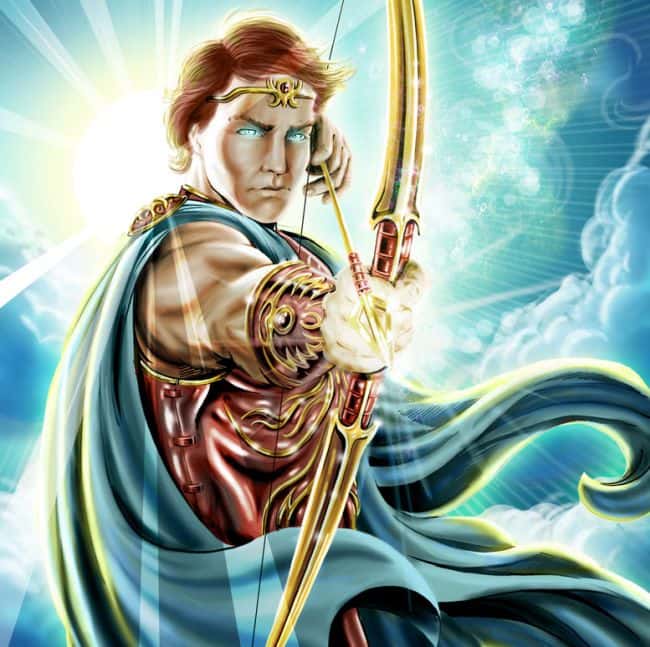
Apollo (or Apollon) was hailed as one of the most important Olympians when it came to the pantheons of both ancient Greeks and Romans. He was the archetype of the beardless, youthful being (kouros), who was also considered the divine entity of light, music, prophecy, poetry, medicine, and archery (symbolized by a silver bow).
The son of Zeus and Leto (daughter of Titan Koios or Coeus and Phoebe), in the mythical narrative, Apollo played a number of seemingly contradictory roles, ranging from that of a monster slayer (who slew the serpent Python and the giant Tityos), music contestant (who defeated the satyr Marsyas) to a murderer (who killed the lesser Cyclopes), and even a plague bearer (with the epidemic being unleashed on the Greek soldiers after the Trojan War).
In this oscillation between benevolence and spite, the aspects of Apollo are also pretty complex, with some primary ones embodying the nature of light and the sun (thus Apollo was associated with or replaced the Titan Helios in Hellenistic times, circa 3rd century BC). Others were associated with places of worship, healing and medicine, prophecy, music, and even wolves. Historically, Apollo was regarded as the oracular Greek god and patron of Delphi.
And since we brought up history, the name Apollo, unlike a number of other Greek gods, doesn’t come up in the Linear B script. In essence, even the origins of Apollo in the pantheon of ancient Greece are mired in mystery, with the etymology of the word Apollon (‘Apollo’ is the Latin form of Greek ‘Apollon’) possibly harking back to a pre-Greek era.
For example, a Hittite entity Apaliunas is mentioned in the Manapa-Tarhunta letter, which in turn might have been derived from Aplu Enlil – meaning the son of the Mesopotamian god Enlil.
Artemis – The Goddess of Hunt
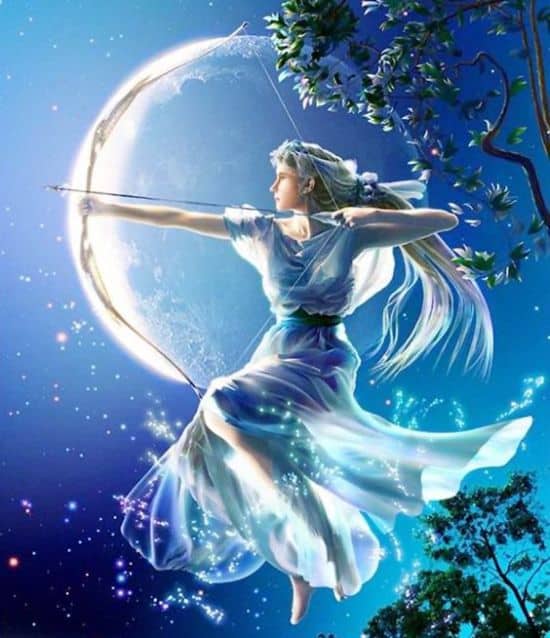
In the mythical narrative it is said after being born, Artemis helped her mother to deliver her twin brother, Apollo, thus embodying the aspects of labor and childbirth. At the same time, she was eternally chaste and a virgin, thus serving a paradoxical connection to childbirth.
But more importantly, among the Olympian gods and goddesses, she was associated with the hunt, forests (especially cypress tree), and the moon – with the latter embodiment possibly allowing her to supersede Selene, the Titan goddess of the moon.
This is what Ist century BC Stoic philosopher Quintus Lucilius Balbus (noted by Cicero in his book De Natura Deorum or ‘On the Nature of the Gods’), had to say about Diana, the ancient Roman equivalent of Artemis –
People regard Diana and the moon as one and the same. … the moon (luna) is so-called from the verb to shine (lucere). Lucina is identified with it, which is why in our country they invoke Juno Lucina in childbirth, just as the Greeks call on Diana the Light-bearer. Diana also has the name Omnivaga (“wandering everywhere”), not because of her hunting but because she is numbered as one of the seven planets; her name Diana derives from the fact that she turns darkness into daylight (dies). She is invoked at childbirth because children are born occasionally after seven, or usually after nine, lunar revolutions…
Interestingly enough, as was virgin Artemis’ paradoxical connection to childbirth, the Greek goddess also embodied other seemingly conflicting aspects, ranging from the purity and serenity of woods and wildlands to the unpredictable and ever-changing nature of the moon.
As for the historical side of affairs, while the origins of Artemis are still debated, with hypotheses ranging from her Phrygian etymology to association with pre-Classical bear cults, there is no doubt that the deity was held in high regard. To that end, the Temple of Artemis at Ephesus, possibly dedicated to a local variant of the goddess of the hunt, was counted among one of the ancient seven wonders of the world.
Hermes – The Messenger God
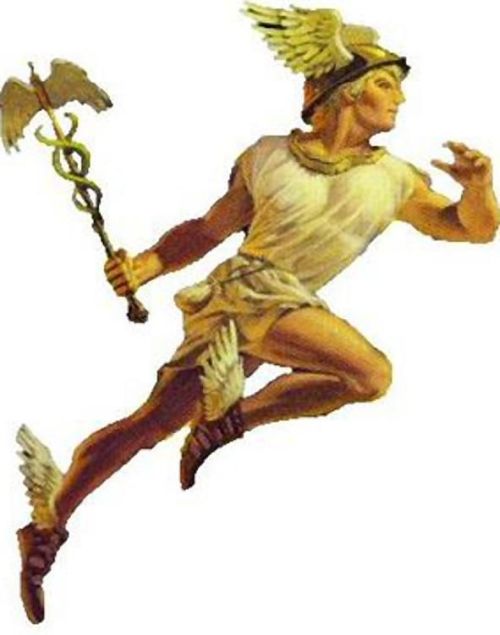
Hermes, the son of Zeus and Maia (one of the daughters of Titan Atlas), was inducted into the exclusive rank of the twelve Olympian Greek gods after he demonstrated his inherent craftiness even as an infant.
According to one particular episode, he was able to steal the cattle of Apollo and also craft a lyre out of a tortoiseshell, when he could barely move out of his crib. Impressed by these clever efforts, Zeus personally made Hermes his herald and messenger.
Mirroring the astute and sometimes shrewd nature of his feats, Hermes was regarded as the Greek god of various aspects, ranging from herds and flocks, travelers and hospitality, roads and trade to diplomacy, language, and writing, athletic contests, and even thievery.
To that end, Hermes, by virtue of his special winged sandals (talaria), a winged hat (petasos), and a magic wand (with two snakes), could quickly travel between worlds, thus serving as a messenger of gods for the mortals. He also fulfilled his role as the conductor of the souls into the afterlife.
As for the historical side of affairs, the first mention of Hermes, like other Greek gods (including Zeus, Dionysus, and Athena), was found in a Linear B script (thus alluding to his Mycenaean origins), while his oldest sanctuary possibly corresponds to Mount Cyllene in Arcadia. And as one of the well-known Greek gods, Hermes was depicted as either a bearded man or a non-bearded youth, often traveling with his winged gear and a herald’s wand.
Hestia – The Goddess of Hearth

Hestia (or Ἑστία in Greek) refers to the ‘hearth’ or ‘fireside’, and as such, she was venerated as the virgin goddess of the hearth. In the mythical narrative, she is considered the oldest daughter (or probably the first-born child) of the Titans Kronos and Rhea – and as such, her character was often associated with the concept of pureness and peace.
Consequently, she was perceived as the deity of domesticity, family, and home – with the very nature of primal fire (in hearths) being viewed as the sacred element of every household (for cooking and heat).
Interestingly enough, the polis (city) was seen as the extension of the family (or tribe), and thus Hestia was also venerated as the presiding deity over the civic hearth in the prytaneion (town hall). In the historical context, even settlers who founded their cities and colonies away from the Greek mainland often carried the flame from Hestia’s public hearth in the mother city as a symbolic gesture of unity.
Now in spite of Hestia’s connection to sacredness and purity, there are few myths associated with the Greek goddess of the hearth – so much so that many later stories replaced Hestia with Dionysus (discussed later) as one of the 12 Olympian Greek gods.
As for her depictions, conforming to her aspect of domesticity, Hestia was often portrayed as a middle-aged woman with modest attire, carrying a staff or flowers with the fire (or hearth) in the background.
Honorable Mention: Dionysus – The God of Wine
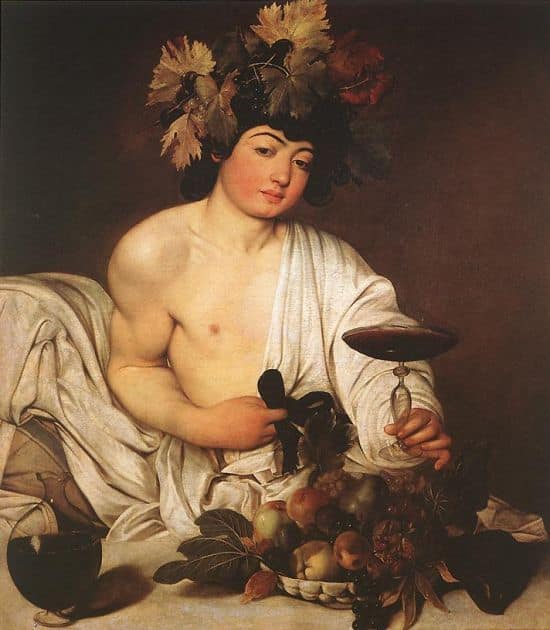
While sometimes counted among the Twelve Olympians (in place of Hestia, especially in later myths), Dionysus was unique in the sense that he had a mortal mother. The son of Zeus and Semele, a daughter of Cadmus (king of Thebes), in the mythical narrative, his birth took a tragic turn.
That is when Hera, apparently out of jealousy, tricked the pregnant Semele to persuade Zeus to appear in his original god-like form in front of her. But the exuberant power was too great for the mortal as she died from the crackling thunderbolts. But Zeus managed to save their child by sewing him up in his thigh, and thus Dionysus was ‘twice-born’ as he emerged from Zeus upon reaching maturity.
In Greek mythology, Dionysus was the god of vegetation and winemaking, but his aspects began to take a ‘wilder’ route, thus being also associated with festivity, revelry, pleasure, and ecstasy.
The undertone of frenzy and its uncontrollable nature is often mirrored in the mythical narrative, with the followers of Dionysus (mainly women), called bacchantes, often portrayed as having the ability to possess occult power (that could charm animals) and extraordinary strength (that could tear ordinary people to pieces), albeit in momentary phases. In essence, Dionysus represented the uncontrollable, potent life force (‘sap’) of nature.
And when it comes to history, the origins of Dionysus as one of the ancient Greek gods take an interesting turn, with mention of his name in a Linear B tablet, dating from the Late Mycenaean period, circa 13th century BC.
His subsequent cults were possibly foreign in origin, and by the Roman times, the ancient rites of Dionysus (or Bacchus) in some part remained mysterious and were rather scandalous, as was attested by Livy. He talked about how the cults practiced wine-fueled violence and rampant sexual promiscuity, accompanied by cacophonous music – thus giving way to the term ‘bacchanalian’, meaning a ‘drunken feast’.
Summary –
Primordial Greek Gods (First Generation) –
Gaia – The Greek goddess who plays the role of a primordial deity (protogenos), thereby regarded as the mother of all creation and associated with the Earth.
Ouranos – Also called Uranus, Ouranos was one of the protogenoi associated with the Sky and thus also regarded as the companion to Gaia – symbolized by the Earth.
The Major Titans (Second Generation of Greek Gods) –
Kronos – The leader of the Titans (who were the offsprings of the protogenoi or primordial deities), Kronos or Cronus was associated with time, fate, justice, and sometimes even evil doings.
Hyperion – The Titan embodies the heavenly light, while his sister/wife Theia (meaning ‘divine’) was the manifestation of the brightness of the blue sky.
Oceanus – The Titan (also called Okeanos) personified the massive river Okeanos that was thought to have encircled Earth itself, thereby being associated with all freshwater.
Atlas – The Titan tasked (or rather punished) with carrying the weight of the heavens on his shoulders.
Prometheus – The Titan is credited with the creation of human life and is associated with fire and kilns.
The Olympian Gods (Third Generation) –
Zeus – The son of Kronos, Zeus was also the King of the Olympians (descendants of Titan Kronos) who overthrew his father and other Titans, and thus became the supreme deity of the Greek pantheon. He was associated with the sky, weather, law and order, destiny and fate, and kingship.
Poseidon – One of the brothers of Zeus, Poseidon was regarded as the lord of the seas, floods, and droughts, while also being associated with earthquakes and horses.
Hades – The eldest of the Olympians and elder brother of Zeus, the ever-mysterious (and often ominous) god was the ruler of the Underworld.
Hera – The queen of the Olympian Greek gods and the sister/wife of Zeus, Hera embodied the aspects of marriage, women, childbirth, and even the stars in heaven.
Demeter – Another daughter of Kronos, Demeter was venerated as the Greek goddess of agriculture, harvest, grain, and bread.
Aphrodite – A unique deity who was (sometimes) considered as one of the direct descendants of the Primordial Greek gods and yet not counted as a Titan (but rather worshipped as an Olympian), Aphrodite was associated with beauty, love, and pleasure.
Athena – The daughter of Zeus (birthed from Zeus’ forehead), Athena was regarded as the ancient Greek goddess of both endurance and strategic warfare, while she also embodied the aspects of wisdom, strength, and reason.
Ares – The son of Zeus and Hera, Ares embodied the ‘battle lust’, thus considered the Greek god of war.
Hephaistos – The son of Hera (and in some narratives – Zeus), the crippled Hephaistos (or Hephaestus) was the master blacksmith of the Olympians, thus representing the aspects of fire, metallurgy, and crafts.
Apollo – The archetype of the beardless, youthful being (kouros), Apollo, a son of Zeus (and a Titan), was considered the divine entity of light, music, prophecy, poetry, medicine, and archery.
Artemis – The twin sister of Apollo, she was associated with the hunt, forests, and the moon.
Hermes – Another son of Zeus (and a Titan), Hermes, the Messenger God, was regarded as the deity of various aspects, ranging from herds and flocks, travelers and hospitality, roads and trade to diplomacy, language and writing, athletic contests, and even thievery.
Hestia – The eldest daughter of Kronos and Rhea, Hestia was the Greek goddess of the hearth, home, domesticity, and unity.
Dionysus – The son of Zeus and a mortal, Dionysus was the Greek god of vegetation and winemaking, but his aspects began to take a ‘wilder’ route, thus being also associated with festivity, revelry, pleasure, and ecstasy.
The Family Tree of Greek Gods and Goddesses –

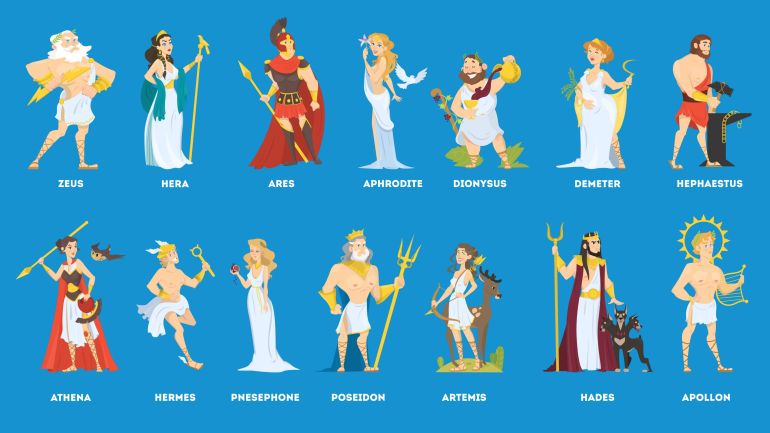
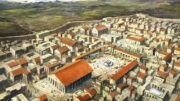
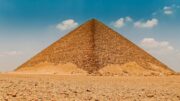
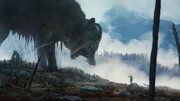
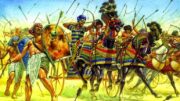
Be the first to comment on "All-Powerful Olympian Greek Gods and Titans You Should Know About"